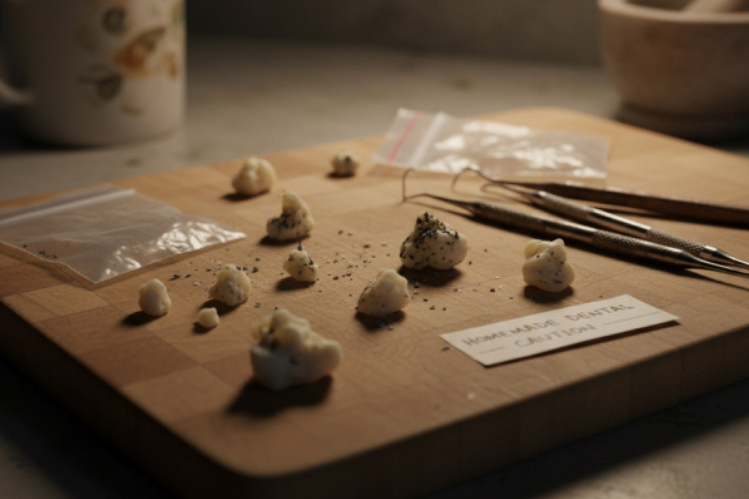
Table of Contents
- What a Filling Actually Does
- Why People Try Filling Teeth Themselves
- A Risky Fix: Making Your Own Filling
- The Truth Behind the “Permanent” Label
- What Could Go Wrong With At-Home Permanent Fillings (and Often Does)
- The Myths People Still Believe
- What’s Actually Safe to Do at Home
- How Teenagers Are Especially at Risk
- When DIY Makes Things Worse
- Why Professional Fillings Last So Long
- Understanding the Bigger Picture
- Prevention Will Always Beat Repair
- The Bottom Line on Homemade Fillings
- FAQ
It usually starts with a dull ache, a sudden chip, or that strange, rough edge you feel with your tongue. For a lot of people, that tiny moment of panic turns into a quick Google search: How to do a permanent tooth filling at home? Scrolling down a few results will reveal endless videos and DIY kits that promise quick fixes, smooth finishes, and zero dental visits. The idea of patching up your own tooth in the comfort of your own bathroom can seem like a dream: no waiting rooms, no drills, no bills. But is it really that simple? Let's peel back the truth.
What a Filling Actually Does
Before diving into at-home options, it's worth understanding what a filling really is. A permanent dental filling isn't just about plugging a hole. It's a meticulous process that stops bacteria from spreading, restores structure, and ensures your tooth can function as part of your bite again.
Dentists use materials like composite resin, ceramic amalgam, or even gold alloys for professional permanent fillings. Each option is applied under clean, controlled conditions after the dentist removes every trace of decay. Removing decay is an essential step; without it, a filling simply seals in bacteria, which continue eating away at your tooth from the inside.
That's what separates professional care from the illusion of a dental filling at home.
Why People Try Filling Teeth Themselves
Money. Time. Fear. Those are usually the three big reasons. Dental visits can be expensive, and for some people, they're downright intimidating. So when the internet promises a shortcut like a homemade permanent tooth filler or a permanent tooth repair kit the temptation makes sense.
These kits often include a soft compound, like a teeth cement filling, which hardens once it's placed into a cavity or crack. They're marketed as “simple to use” and “dentist-approved”. Some even claim to be the best permanent tooth filling at home, implying they'll last for months or years. The catch is: they rarely do.
A Risky Fix: Making Your Own Filling
One of the riskiest ways someone can attempt to treat tooth decay at home is with a filling they have made themselves. These crude DIY fillings are often made from materials that aren't safe for orthodontic treatment, such as baking soda, soap, wax, and even plaster or cement.
Mostly unreliable and ill-fitting, they can also be a direct threat to your oral health. Often this makes the decay worse, irritating your gums and possibly leading to infections due to their unsanitary nature.
It is absolutely not recommended to use an entirely homemade filling. If you must use some sort of temporary fix, pharmaceutically approved filling kits are preferable, but still not ideal. Despite being a safer option than homemade fillings, most DIY filling kits make exaggerated claims about their durability and permanence. Neither are substitutes for proper dental care.
The Truth Behind the “Permanent” Label
Let's set the record straight. There is no such thing as an at-home permanent tooth filling. Every DIY kit you can buy is temporary. Even those claiming to last months don't match the strength or precision of professional work.
Real dental fillings require clean surfaces, moisture control, and specialized curing tools. Even if you manage to apply a cavity filler at home correctly, the underlying decay isn't removed. The bacteria are still in there, waiting. Over time, that small patch can turn into a deep infection, which may eventually require a root canal or extraction.
What Could Go Wrong With At-Home Permanent Fillings (and Often Does)

The risks of using at-home kits might not be obvious right away, but they can snowball into serious problems.
You Can't Stop Decay Without Removing It
If decay isn't cleaned out, it keeps spreading underneath your permanent tooth filler. Think of it like covering mold with paint; it looks better for a bit, but the rot continues. That's why untreated tooth decay is one of the main causes of infection beneath failed DIY fillings.
The Fit Is Almost Never Right
Dentists spend years learning how to shape fillings so that they match your bite perfectly. When you press putty into your tooth at home, the fit is guesswork. That uneven surface can change how your teeth close together, and over time, this misalignment can create gaps in teeth or jaw tension.
Infection Is a Real Threat
DIY kits aren't sterile. Even if you clean, bacteria remain in the tiny crevices of your mouth. Once sealed in, they thrive. Pain, swelling, and fever are all possible results of a dental filling at home that goes wrong.
You Might Crack the Tooth Further
When using a permanent tooth repair kit, some people bite down to “set” the filler. The pressure from doing this can cause fine cracks to spread, especially in weakened enamel. A cracked tooth not only hurts it can also expose the inner pulp, leading to serious nerve pain.
The Damage Isn't Always Immediate
That's what makes this so tricky. Many people will think their at-home fix worked fine, until weeks later when the pain suddenly worsens. What was once a small cavity may have turned into an infection that spreads to the root.
The Myths People Still Believe
At-home dental fillings are surrounded by plenty of misinformation. We’re going to debunk some of the most common myths regarding homemade fillings:
Home-Made Fillings Are Safe
Not at all. Making your own filling out of spare materials at home poses a genuine risk to your oral health. It isn't just risky to attempt orthodontic procedures without adequate training; the materials commonly used (cement, plaster, etc.) are not medically approved.
The fillings will be loose, lack strength, and can cause a variety of issues inside your mouth, from worsening tooth decay to infections caused by the lack of a sterile procedure.
It's the Same Stuff Dentists Use
Not quite. Professional-grade filling materials are cured using UV lights, shaped with special tools, and placed after the tooth is disinfected. The compounds in home kits may look similar, but their adhesive strength and safety aren't the same.
It’s Safe Because It’s Sold Online
False. Many permanent tooth filler kits online are unregulated imports. They might contain questionable chemicals or cause allergic reactions. Without FDA approval or dental supervision, there’s no guarantee they’re safe for long-term contact.
It’ll Last Just Fine until I Can Afford a Dentist
Sometimes that’s true, for a few days at least. But DIY fillings can pop out easily when exposed to chewing pressure, hot drinks, or saliva. When they do, you’re back to square one, except now the cavity might be deeper.
What’s Actually Safe to Do at Home
There are situations where temporary fixes can make sense, like if your filling fell out over the weekend or you’re travelling and can’t see a dentist right away. In those moments, a teeth cement filling at home can provide short-term comfort. If you must use one, here's what to do:
- Rinse your mouth thoroughly with warm salt water.
- Avoid eating on that side of your mouth.
- Follow the instructions carefully and only use a small amount.
- Treat it as temporary and get professional help as soon as possible.
Temporary doesn't mean permanent, no matter what the packaging says.
How Teenagers Are Especially at Risk
Teens experimenting with at-home fixes often misunderstand the long-term impact of neglecting cavities. Dental problems in teens often start small tiny pits or dark spots, but worsen quickly without proper care. A temporary filler might make things painless for a while, but it won't stop bacteria from eating through enamel.
That's why regular checkups and cavity prevention are so important during adolescence, when diet and hygiene habits are still forming.
When DIY Makes Things Worse
Dentists often see patients who have tried to fill a tooth themselves and ended up needing more invasive procedures later. Some report bits of hardened material lodged under the gum line or infections spreading to the jaw.
One of the worst cases is when a person uses an unapproved permanent filling product that contains heavy metals or industrial adhesives. The results can include gum burns, tissue irritation, or even systemic toxicity if the material breaks down.
No permanent dental filling available over the counter is tested to the same safety standards as professional products.
Why Professional Fillings Last So Long

A real permanent filling is built to last years, sometimes decades. Because it's more than a plug. Dentists isolate the tooth from saliva, remove decay, and use bonding agents to create a chemical link between the tooth and the material. That's what prevents microleakage and reinfection.
When a permanent tooth filling at home skips these steps, the filler can't seal properly. Moisture seeps in, bacteria thrive, and the “permanent” fix dissolves within weeks.
Understanding the Bigger Picture
The popularity of DIY fillings isn't just about convenience; it's about trust, affordability, and access. In many places, dental care feels out of reach. But long-term, a poorly done cavity filler at home ends up costing far more when the damage spreads.
Think of it like this: a dentist isn't just patching up your tooth. They're preserving its structure, checking for infection, and ensuring your overall oral health stays stable. That's a lot more than any permanent tooth repair kit can do.
Prevention Will Always Beat Repair
Here’s the truth nobody selling a filler kit will tell you: the easiest cavity to treat is the one that never forms. Good daily habits like brushing twice with fluoride toothpaste, cutting down on sugary snacks, and regular dental cleanings dramatically reduce your chances of decay.
Gaps in your teeth, increased sensitivity, or minor chipping all indicate that a dentist visit is needed. Early intervention is what keeps problems from becoming painful and expensive.
The Bottom Line on Homemade Fillings
Trying a permanent tooth filling at home can seem like a small, smart shortcut, especially when dental care feels overwhelming. But the truth is, these kits were never meant to replace professional treatment. They’re temporary tools, band aids at best, ticking time bombs at worst.
You should always treat homemade fillings as short-term relief until you can see a professional. Your smile deserves more than a shortcut. Healthy teeth aren't just about appearance; they're about confidence, comfort, and long-term health. And no matter how convincing a label sounds, nothing beats the precision, safety, and care of a trained dental expert.
FAQs
1. Is it safe to fill a tooth at home?
Not really. DIY fillings can trap bacteria, worsen decay, and lead to infection. They're meant for temporary use only.
2. What is the safest type of filling?
Composite resin and ceramic fillings are widely considered the safest and most aesthetic materials.
3. What are the symptoms of metal poisoning from fillings?
Modern fillings rarely cause metal toxicity, but older amalgams can occasionally trigger sensitivity. Persistent fatigue, headaches, or metallic taste should be checked by a doctor.
4. Why shouldn't you get fillings?
You should get fillings if needed; skipping them allows cavities to worsen, risking tooth loss.
5. How to prevent mercury toxicity in dentistry?
Today's fillings are mercury-free. If you're worried, request composite or glass ionomer materials from your dentist.
6. What do holistic dentists use to fill cavities?
Holistic practitioners often prefer natural biocompatible materials like BPA-free composites or ceramic-based compounds.
Citations:
Worthington, H. V., Khangura, S., Seal, K., Mierzwinski-Urban, M., Veitz-Keenan, A., Sahrmann, P., Schmidlin, P. R., Davis, D., Iheozor-Ejiofor, Z., & Alcaraz, M. G. R. (2021). Direct composite resin fillings versus amalgam fillings for permanent posterior teeth. Cochrane Library, 2021(8). https://doi.org/10.1002/14651858.cd005620.pub3
Armstrong, S. (2017, November 29). The rise of DIY dentistry: Britons doing their own fillings to avoid NHS bill. The Guardian. https://www.theguardian.com/society/2015/apr/03/rise-of-diy-dentistry-britons-doing-own-fillings-to-avoid-nhs-bill






